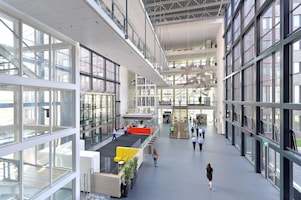
Energy Transition Campus Amsterdam
Energie staat al meer dan honderd jaar centraal aan de Noordkant van het IJ. De ETCA in Amsterdam is een van de drie belangrijkste onderzoekcentra van Shell wereldwijd. Nieuwe ideeën, technologie en decennia aan ervaring komen hier samen om in de energiebehoeften van vandaag en morgen te voorzien.

Veel meer over de ETCA op de speciale website
De Energy Transition Campus Amsterdam is een innovatieve plek waar knappe koppen de energie-uitdagingen waar we voor staan te tackelen.
More about the ETCA in English? Visit the special website
De Energy Transition Campus Amsterdam is an innovative hotspot where great minds come together to tackle the world’s biggest energy challenges.
Laatste nieuws

Nieuw pleidooi voor behoud Nederlandse basisindustrie
Samen tegen de deïndustrialisatie van Nederland en met de overheid werken aan concurrerend duurzaam worden. Om zo te bouwen aan een toekomstbestendige economie die werkt voor mens, milieu en Europa. Dat is in het kort de inhoud van het op 1 december verschenen pleidooi “Een basisindustrie om op te bouwen: nu & in de toekomst” van de Industriecoalitie. Shell onderschrijft de conclusies van dit bidbook, gemaakt door het platform van bedrijven en belangenverenigingen uit de Nederlandse basisindustrie.

LeapSprong: krachten bundelen voor een duurzamere industrie
Innovatie, samenwerken, start-ups: de ideale ingrediënten voor vernieuwing. En die is hard nodig binnen een industriecluster dat nog grotendeels draait op fossiele brandstoffen, maar vastbesloten is om te verduurzamen. Acht start-ups staan in de startblokken om kansen te zoeken om de energietransitie in de regio Amsterdam te versnellen. Ze doen mee aan LeapSprong: een innovatieprogramma dat regionale uitdagingen in de energietransitie wil aanpakken.

"Shells bijdrage aan de Nederlandse economie en energiezekerheid onmiskenbaar"
Shells bijdrage aan de economie en energiezekerheid in Nederland waren ook in 2024 onmiskenbaar. Dat blijkt uit het nieuwste rapport over de sociaal-economische bijdrage van Shell in Nederland van economisch adviesbureau Oxford Economics. Shells belang is zichtbaar in tienduizenden banen, investeringen in de energietransitie en doorontwikkelingen van innovatieve technologieën, vaak samen met partners.
Meer over de ETCA
Nieuw leven, samenwerking met start-ups, scale-ups en academici
Het voormalig Shell Technology Centre Amsterdam begint in 2021 aan een nieuw leven als Energy Transition Campus Amsterdam. Samenwerking tussen het bedrijfsleven en academici voor de energietransitie is en blijft cruciaal. Daarom heeft Shell besloten om de deuren van het onderzoekscentrum in Amsterdam te openen voor start-ups, scale-ups, kennisinstituten, academici en bedrijven die werken aan oplossingen voor de energietransitie.


Onderzoek op de ETCA
Wereldwijd staat de samenleving de komende decennia voor een uitdaging. Terwijl de maatschappij steeds minder broeikasgassen moet gaan uitstoten, zal door de groeiende wereldbevolking en stijgende welvaart het energieverbruik toenemen. Efficiënter gebruik en schonere energie zijn de kern van een groot deel van de onderzoeksactiviteiten binnen onderzoeksactiviteiten van Shell in Amsterdam.
Op de ETCA doet Shell samen met partners winningsonderzoek, gastechnologisch onderzoek en wordt de sleutelrol voor katalyse voor de stap van fossiele naar hernieuwbare energie beproefd.. Maar ook worden digitale technologieën als drones, virtual reality en kunstmatige intelligentie bekeken. De ingenieurs op de ETCA ontwerpen, bouwen en onderhouden de meeste van de 1300 testinstallaties en proefopstellingen zelf.


